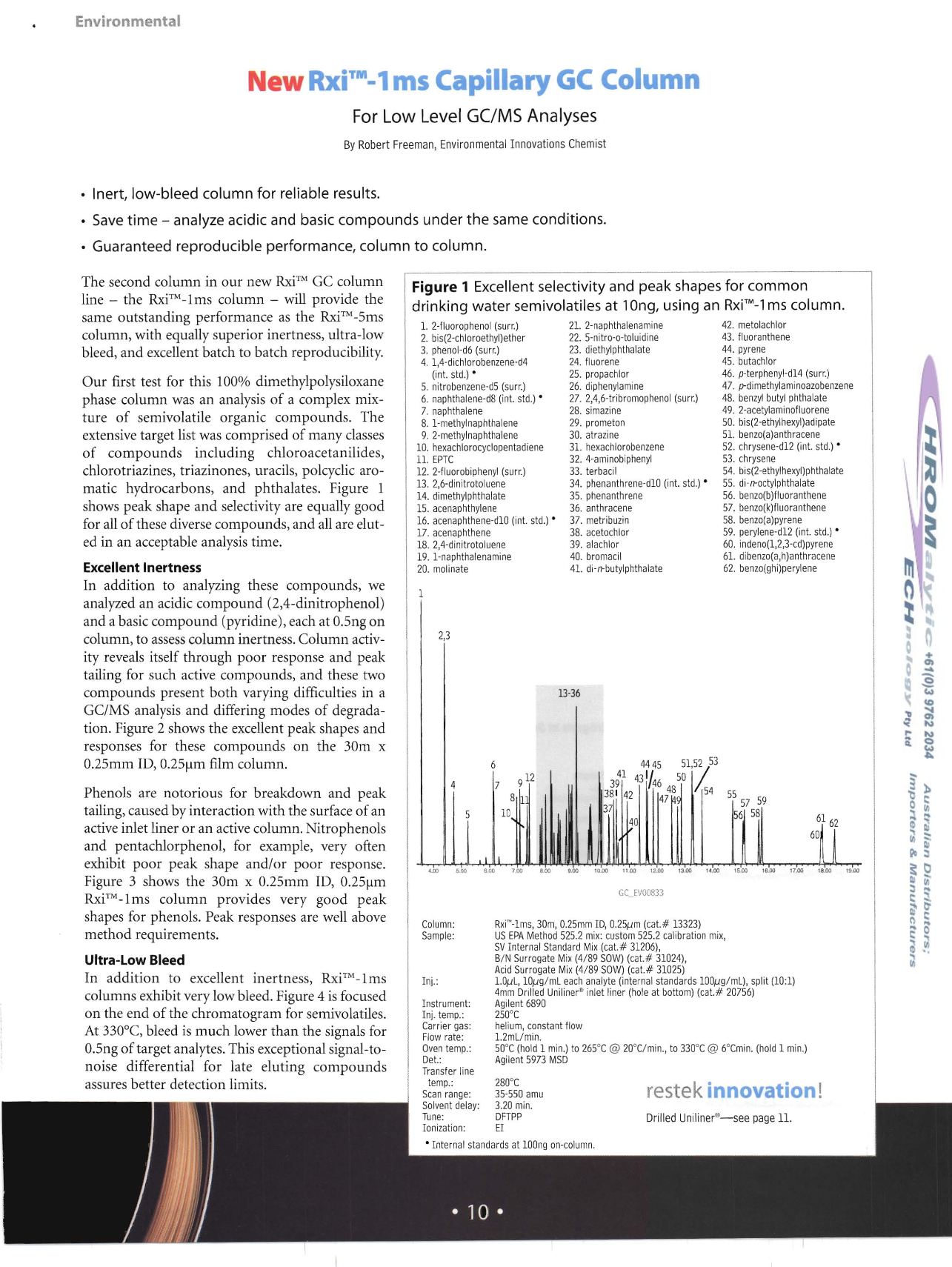

Environmental
NewRxi™-1 ms Capillary GC Column
For Low Level GC/MS Analyses
By
Robert Freeman, Environmental Innovations Chemist
• Inert, low-bleed column for reliable result s.
Save time - analyze acidic and basic compounds under the same conditions.
Guaranteed reproducible performance, column to column.
The second column in our new
Rxi"
GC column
line - the Rxi™-lms column - will provide the
same outstanding performance as the Rxi™-Sms
column, with equally superior inertness, ultr a-low
bleed, and excellent batch to batch reproducibility.
Our first test for this 100% dimethylpolysiloxane
phase column was an analysis of a comple x mix
ture of semivolatile organic compounds . The
extensive target list was comprised of many classes
of compounds including chloro acet ani lides,
chlorotriazines, tria zinon es, uracils, polcyclic aro
matic hydrocarbons, and phthalates. Figure 1
shows peak shape and selectivity are equally good
for all of these diverse compounds, and all are elut
ed in an acceptable analysis time .
Excellent Inertness
In addition to analyzing these compounds, we
analyzed an acidic compound (2,4-dinitrophenol)
and a basic compound (pyridine), each at O.5ng on
column, to assess column inertness. Column activ
ity reveals itself through poor response and peak
tailing for such active compounds, and these two
compounds present both varying difficulties in a
GC/MS analysis and differing modes of degrad a
tion . Figure 2 shows the excellent peak shapes and
respons es for these compounds on th e 30m x
0.25mm !D, 0.25flm film column.
Pheno ls are notorious for breakdown and peak
tailing, caused by interaction with the surface of an
active inlet liner or an active column. Nitrophenols
and pentachlorphenol, for exampl e, very often
exhibit poor peak shape and /or poor response.
Figure 3 shows the 30m x 0.2Smm !D, 0.2Sflm
Rxi™_lms column provi des very good peak
shapes for pheno ls. Peak responses are well above
method requirements.
Ultra-Low Bleed
In addition to excellent inertness, Rxi
H I
-l ms
columns exhibit very low bleed. Figure 4 is focused
on the end of the chromatogram for semivolatiles.
At 330°C, bleed is much lower than the signals for
O.5ngof target ana lytes. This exceptional signal-to
no ise differential for late eluting compounds
assures better detection limits.
Figure 1
Excellent select ivity and peak shapes for common
drinking water semivolatiles at lOng, using an Rxi™-lms column.
1. 2-fluorophenol (surr.)
21. 2-naphthalenamine
42. metolachlor
2. bis(2-chloroethyl)ether
22. 5-nitro-o-toluidine
43.fluoranthene
3. phenol-d6(surr.)
23. diethylphthalate
44. pyrene
4. 1,4-dichlorobenzene-d4
24.fluorene
45. butachlor
(int. std.) •
25. propachlor
46. p-terphenyl-d14(surr.)
5. nitrobenzene-d5(surr.)
26. diphenylamine
47. p-dimethylaminoazobenzene
6. naphthalene-d8 (int. std.) •
27. 2,4,6-tribromophenol (surr.)
48. benzylbutyl phthalate
7. naphthalene
28.simazine
49. 2-acetylaminofluorene
8. l- rnethylnaphthalene
29.prometon
50. bis(2-ethylhexyl)adipate
9. 2-methylnaphthalene
30. atrazine
51. benzo(a)anthracene
10. hexachlorocyclopentadiene
31. hexachlorobenzene
52. chrysene-d12(int. std.) •
11. EPTC
32. 4-aminobiphenyl
53. chrysene
12. 2-fluorobiphenyl (surr.)
33. terbacil
54. bis(2-ethylhexyl)phthalate
13. 2,6-dinitrotoluene
34. phenanthrene-dl0 (int. std.) • 55. di-n-octylphthalate
14. dimethylphthalate
35. phenanthrene
56. benzo(b)fluoranthene
15. acenaphthylene
36. anthracene
57. benzo(k)fluoranthene
16. acenaphthene-dl fl (int. std.) • 37. metribuzin
58. benzo(a)pyrene
17. acenaphthene
38. acetochlor
59.perylene-d12(int. std.) •
18. 2,4-dinitrotoluene
39. alachlor
60. indeno(1,2,3-cd)pyrene
19. I-naphthalenamine
40. bromacil
61. dibenzo(a,h)anthracene
20. molinate
41. di-n-butylphthalate
62. benzo(ghi)perylene
2,3
13-36
6
4445
51,:%53
4
7 9 12
3~1
43
1/
46 50
8
381 42
4/ 8
54 55
57 59
1
10
37
56 58
40
6~rt
II
!
15.00
11,00
GC EV00833
Column:
Rx
i~-lms
,
30m, 0.25mm
10,
0.251lm
(cat.# 13323)
Sample:
US
EPA Method525.2 mix: custom525.2calibrationmix,
SVInternal Standard Mix (cat.# 31206),
BIN
Surrogate Mix
(4/89
SOW) (cat.# 31024),
Acid Surrogate Mix
(4/89
SOW) (cat.# 31025)
Inj.:
1.01lL,
lOllg/ mL
each analyte (internal standards
lOOllg/ mL),
split (10:1)
4mmDnlled Uniliner" inlet liner (holeat bottom) (cat.# 20756)
Instrument:
Agllent 6890
Inj. temp.:
250' C
Carrier gas:
helium, constant flow
Flow rate:
1.2mL/min.
Oven temp.:
50'C(hold 1 min.)to 265' C
@
20' C/ min., to 330'C
@
6'Cmin. (hold1 min.)
Del.:
Agilent 5973MSD
Transfer line
temp.:
280'C
Scanrange:
restek
innovation !
35-550 amu
Solventdelay: 3.20 min.
Tune:
DFTPP
DrilledUniliner"'- see page11.
Ionization:
EI
Website :
www.chromtech.net.auE-mail :
info@chromatech.net.auTelNo : 03 9762 2034 . . . in AUSTRALIA











